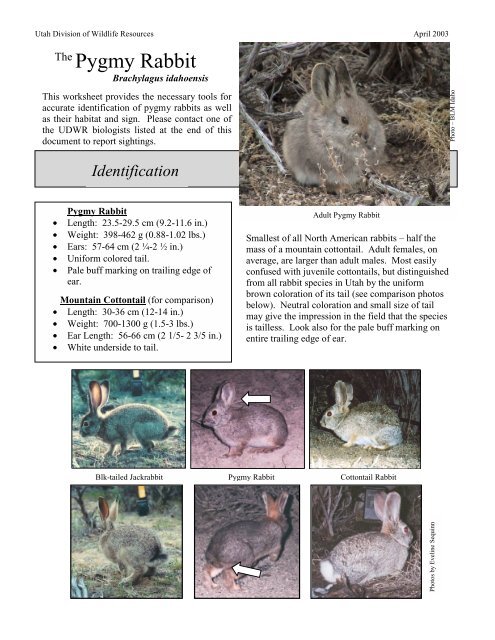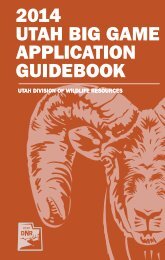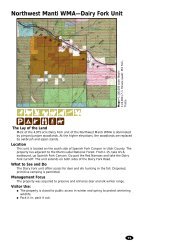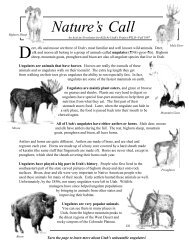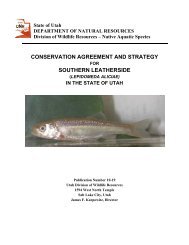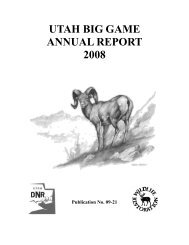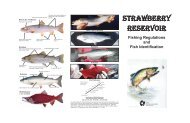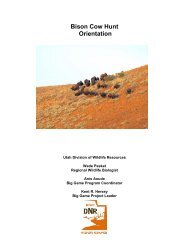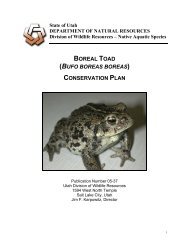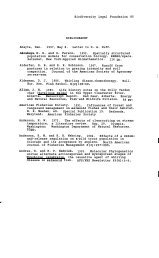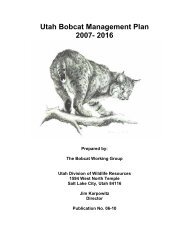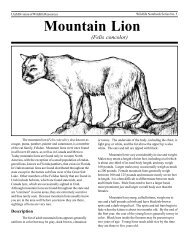The Pygmy Rabbit - Utah Division of Wildlife Resources
The Pygmy Rabbit - Utah Division of Wildlife Resources
The Pygmy Rabbit - Utah Division of Wildlife Resources
You also want an ePaper? Increase the reach of your titles
YUMPU automatically turns print PDFs into web optimized ePapers that Google loves.
<strong>Utah</strong> <strong>Division</strong> <strong>of</strong> <strong>Wildlife</strong> <strong>Resources</strong> April 2003<br />
<strong>The</strong> <strong>Pygmy</strong> <strong>Rabbit</strong><br />
Brachylagus idahoensis<br />
This worksheet provides the necessary tools for<br />
accurate identification <strong>of</strong> pygmy rabbits as well<br />
as their habitat and sign. Please contact one <strong>of</strong><br />
the UDWR biologists listed at the end <strong>of</strong> this<br />
document to report sightings.<br />
Identification<br />
<strong>Pygmy</strong> <strong>Rabbit</strong><br />
• Length: 23.5-29.5 cm (9.2-11.6 in.)<br />
• Weight: 398-462 g (0.88-1.02 lbs.)<br />
• Ears: 57-64 cm (2 ¼-2 ½ in.)<br />
• Uniform colored tail.<br />
• Pale buff marking on trailing edge <strong>of</strong><br />
ear.<br />
Mountain Cottontail (for comparison)<br />
• Length: 30-36 cm (12-14 in.)<br />
• Weight: 700-1300 g (1.5-3 lbs.)<br />
• Ear Length: 56-66 cm (2 1/5- 2 3/5 in.)<br />
• White underside to tail.<br />
Adult <strong>Pygmy</strong> <strong>Rabbit</strong><br />
Smallest <strong>of</strong> all North American rabbits – half the<br />
mass <strong>of</strong> a mountain cottontail. Adult females, on<br />
average, are larger than adult males. Most easily<br />
confused with juvenile cottontails, but distinguished<br />
from all rabbit species in <strong>Utah</strong> by the uniform<br />
brown coloration <strong>of</strong> its tail (see comparison photos<br />
below). Neutral coloration and small size <strong>of</strong> tail<br />
may give the impression in the field that the species<br />
is tailless. Look also for the pale buff marking on<br />
entire trailing edge <strong>of</strong> ear.<br />
Blk-tailed Jackrabbit <strong>Pygmy</strong> <strong>Rabbit</strong> Cottontail <strong>Rabbit</strong><br />
Photos by Eveline Sequinn<br />
Photo – BLM Idaho
<strong>Utah</strong> <strong>Division</strong> <strong>of</strong> <strong>Wildlife</strong> <strong>Resources</strong> April 2003<br />
Photo by Eveline Sequin<br />
<strong>Pygmy</strong> rabbit pellets with Leatherman for size reference.<br />
Habitat: Several aspects <strong>of</strong> pygmy rabbit ecology create an<br />
extremely close association between the rabbits and dense,<br />
tall stands <strong>of</strong> sagebrush. <strong>Pygmy</strong> rabbits are the only rabbits<br />
in North America to dig their own burrows. Landscape<br />
selection by rabbits is linked very closely with the<br />
availability <strong>of</strong> deep, loose soils in which to construct burrows<br />
(2-7 openings). Suitable pygmy rabbit habitat can <strong>of</strong>ten be<br />
found by searching for areas with deeper soils, as recognized<br />
by distinctly taller patches <strong>of</strong> sagebrush. Topography plays a<br />
very important role in soil deposition and therefore rabbit<br />
distribution, so pay special attention to old riverbeds, alluvial<br />
fans, and the base <strong>of</strong> hills where soils have slumped.<br />
Sign – Burrows: <strong>Pygmy</strong> rabbits spend the majority <strong>of</strong> their<br />
lives within 30 meters <strong>of</strong> their<br />
burrows, leading to the high<br />
concentration <strong>of</strong> pellets <strong>of</strong>ten<br />
observed. Although the entrance <strong>of</strong> a<br />
burrow dug by pygmy rabbits averages<br />
3-5” in diameter (slightly smaller than<br />
your fist), it is very common for<br />
pygmy rabbits to be using the much<br />
larger burrows <strong>of</strong> other animals. <strong>The</strong><br />
presence <strong>of</strong> pellets at or near the<br />
burrow entrance will be your best<br />
indicator <strong>of</strong> the burrow’s occupancy by<br />
pygmy rabbits. Diet (winter: 81-99%<br />
sagebrush; summer: 51% sagebrush,<br />
39% grasses, 10% forbs) indicates<br />
another important link pygmy rabbits<br />
have to healthy sagebrush ecosystems.<br />
DWR Contacts<br />
Sign – Pellets:<br />
Pellets are round and 2-5 mm in diameter<br />
(similar to what a Tic-Tac looks like end-on).<br />
Several rabbit species can produce similar<br />
pellet sizes, but almost always in association<br />
with larger, more typical pellets. Often pellet<br />
densities are high (even when rabbit densities<br />
are not) due to the rabbit’s habitual behavior.<br />
High densities <strong>of</strong> small pellets are diagnostic.<br />
Habitat & Ecology<br />
<strong>Pygmy</strong> rabbit burrow w/ 35 mm lens cap for Photo by Mike Wolfe<br />
<strong>Pygmy</strong> rabbit habitat: Photo demonstrating sagebrush height/density<br />
response to deeper soils. Note height <strong>of</strong> foreground sagebrush in deep<br />
soils relative to that <strong>of</strong> the background sagebrush in shallower soils.<br />
Adam Kozlowski (801) 476-2740 Counties: Box Elder, Cache, Rich, Weber, Davis, Morgan, Summit<br />
Jackee Alston (801) 491-5663 Counties: Tooele, Salt Lake, Wasatch, <strong>Utah</strong>, Juab, Sanpete<br />
Keith Day (435) 865-6120 Counties: Millard, Sevier, Beaver, Piute, Wayne, Iron, Garfield, Washington, Kane<br />
Brian Maxfield (435) 454-3338 Counties: Daggett, Duchesne, Uintah, Grand<br />
Photo by Mike Wolfe


